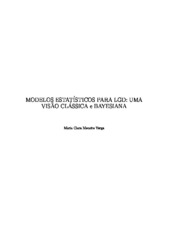Modelos estatísticos para LGD : uma visão clássica e bayesiana
Abstract
Every day in financial institution is common to nd customers who are unable to honor their commitments. When this occurs we say that the individual is in default. In a possible economic downturn the portfolio could su_er losses due to excessive default clients and high loss rates. At this stage it is essential that financial institutions have a capital reserve to absorb this potential loss. This reserve is known as economic capital. We examined four different models, Normal, Log-Normal, Logit-Normal and Beta Regression, used to determine the individual loss rate, since the client is in default, also known as LGD (Loss Given Default). Such models are used to determine the economic capital. In the models, both the default and LGD depend on a single systematic risk factor, which describes the state of the economy. This means that we considered that the event of default and LGD are correlated. We describe in detail for the four models, two ways of calculating economic capital, using the asymptotic approximation of the distribution of loss rate and the normal approximation. Through a simulation study, we compared the different estimates of economic capital. A bayesian approach to the Beta Regression model is developed modeling mean and dispersion parameter jointly.
